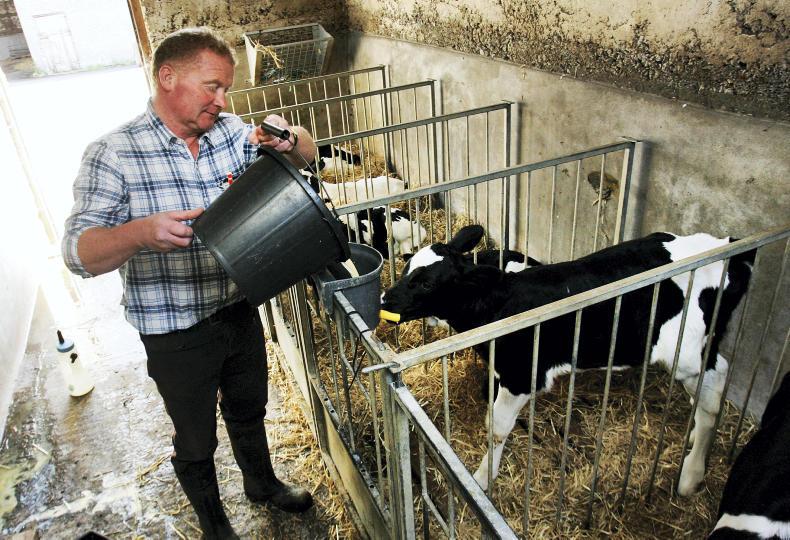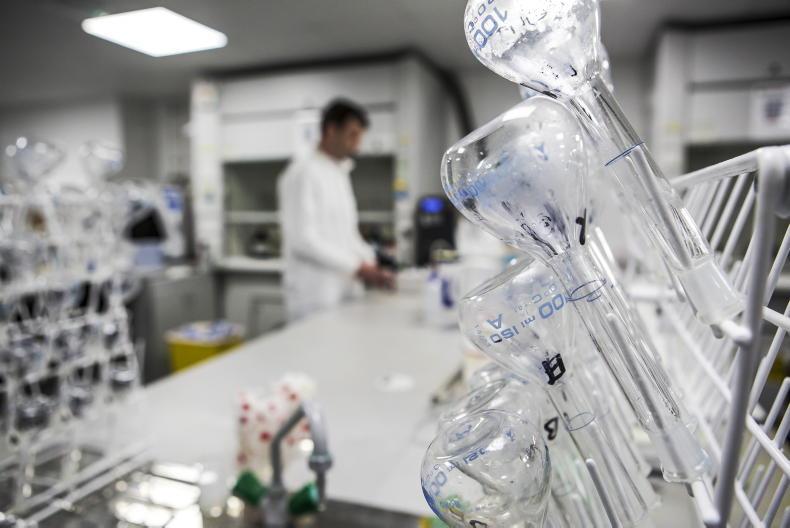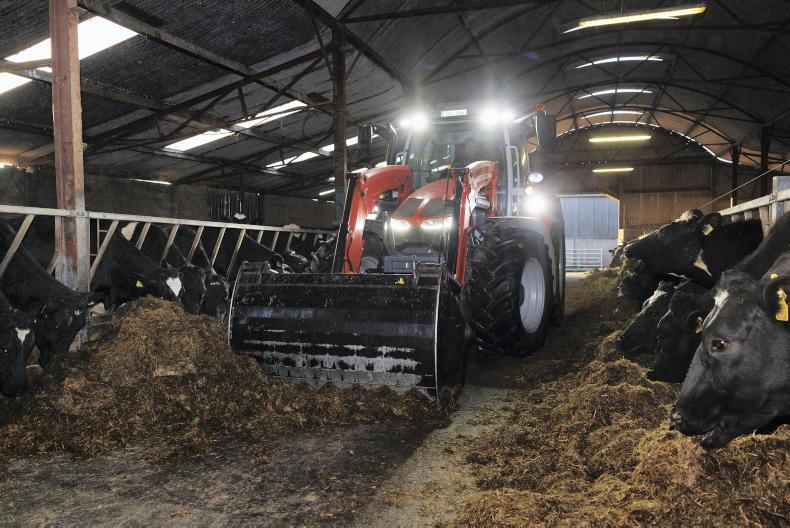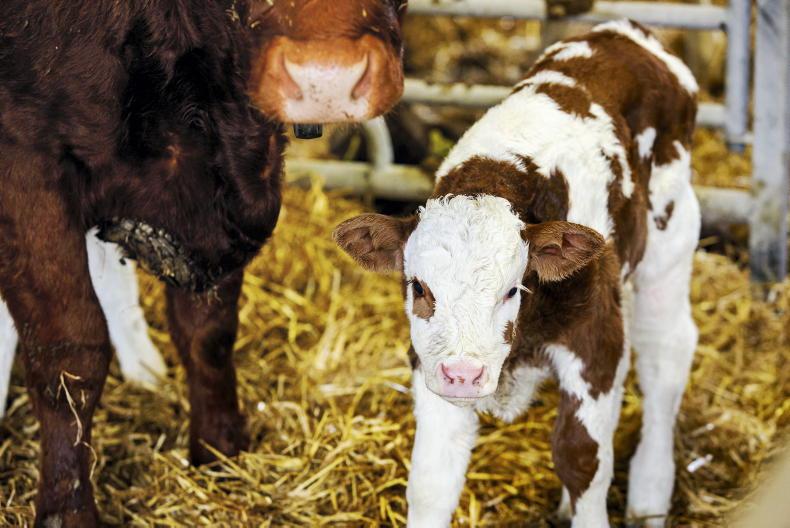Third-cut silage in many parts of the country has bulked well and will help make up for low second-cut yields. To get an understanding of how well silage deficits have been bridged, fodder budgets need to be recalculated.
An updated fodder budget for new Dairylink Ireland participant James King was calculated by programme adviser Conail Keown last week.
It indicates a minor shortfall of 15t on the farm near Ballymena, Co Antrim, over an estimated five-and-a-half-month winter.
It is based on 160 milking cows, with a 1.2t/head/month fresh-weight silage requirement and 63 heifers at 250kg to 350kg liveweight eating 0.65t/head/month. This comes to a total requirement of 1,281t.
Total fresh weight
First- and second-cut is in a pit on the King farm and has a volume of 1,468m2. Average dry matter (DM) in the clamp is 31% and when a conversion factor of 0.6 (based on DM content) is applied, total fresh weight in the pit comes to 881t.
There will be around 550 bales on the King farm between surplus grass and third-cut silage.
Assuming an average DM of 28%, each bale will weigh 0.7t and so 385t will be available. Overall, total silage reserves come to 1,266t fresh weight.
Conducting silage analysis of all fodder to get an understanding of feeding value and DM content is important.
Silage with higher DM content than usual was made on many farms this year and, although it will likely have a lower fresh weight, it could have a higher than expected DM weight.
Some farmers should consider calculating fodder budgets on a DM basis if high-DM silage was made as livestock requirements will be lower than normal (on a fresh-weight basis).
Weekly roundup
With third-cut harvested, fodder budgets are being updated.Most participants should have enough silage for the winter.Calving and calf rearing is ongoing on programme farms.Grazing blocks will be closed from the start of October.Animal health plans are developing for group members.Farmer focus: James King, Ballymena, Co Antrim
A fodder budget for the winter ahead was recalculated last week and shows a slight shortfall of around 15t of silage.
The figures assume that 40 acres of silage that is due to be cut this week will yield five bales per acre and overall DM content of baled silage averages 28%.
The big unknown is the actual length of the winter period, as this can vary significantly between years.
The first cows were not turned out to grass until 16 April this year, compared with 16 March the year before.
The calculations are for a five-and-a-half-month housing period and we will continue to revise the fodder budget during the winter.
The calculations highlight that things could be tight, so we will make sure not to carry any passenger livestock over the winter and we might keep an eye out for fodder for sale.
The dry weather during the summer meant the second cut was lighter than hoped and we had to feed out three bales of silage a day to milking cows for two weeks.
Growth came back well after this and was over 50kg DM/ha/day up until last week.
Cows are at grass full-time, but are being supplemented with a few kilos of silage after milking.
This is because urea levels in milk were above 35mg/100ml. This indicates excess protein in the diet, which was coming from nitrogen in grass.
Holstein herd
We are milking 160 Holstein Friesian cows in an autumn-calving system. Average yield is 7,500 litres at 4.07% butterfat and 3.27% protein from 3t of concentrates.
I am a new participant on the Dairylink Ireland programme and I want to increase milk yields by improving herd fertility over the next few years.
Reducing calving interval from 420 days to 380 days could be worth an extra 1,000 litres, because there will be fewer stale cows and more fresh-calvers going through the parlour.
Calving started on 10 September and 15 cows calved in the first week.
These cows were all served with sexed semen and there was only one bull, which was one of a pair of twins.
Calves born this year are sired by bulls such as Dewars, Maxfli and Cyclone.
After October, cows will only be calving to beef bulls.
Any dairy bulls and beef-bred calves are sold in the mart shortly after birth. Heifer calves are in individual pens and are fed whole milk in single teat feeders.
We have a pasteuriser for calves’ milk, which removes the risk of disease spread, such as Johne’s.
There are four byres used for calf rearing at present, with each one holding seven calf pens.
Calves move out of each byre and into a cubicle house in a group, which allows each room to be pressure-washed and disinfected before a new batch of newborn calves take their place.
Read more
Recent dairy entrant joins Dairylink project
Dairylink: a new phase gets under way
Third-cut silage in many parts of the country has bulked well and will help make up for low second-cut yields. To get an understanding of how well silage deficits have been bridged, fodder budgets need to be recalculated.
An updated fodder budget for new Dairylink Ireland participant James King was calculated by programme adviser Conail Keown last week.
It indicates a minor shortfall of 15t on the farm near Ballymena, Co Antrim, over an estimated five-and-a-half-month winter.
It is based on 160 milking cows, with a 1.2t/head/month fresh-weight silage requirement and 63 heifers at 250kg to 350kg liveweight eating 0.65t/head/month. This comes to a total requirement of 1,281t.
Total fresh weight
First- and second-cut is in a pit on the King farm and has a volume of 1,468m2. Average dry matter (DM) in the clamp is 31% and when a conversion factor of 0.6 (based on DM content) is applied, total fresh weight in the pit comes to 881t.
There will be around 550 bales on the King farm between surplus grass and third-cut silage.
Assuming an average DM of 28%, each bale will weigh 0.7t and so 385t will be available. Overall, total silage reserves come to 1,266t fresh weight.
Conducting silage analysis of all fodder to get an understanding of feeding value and DM content is important.
Silage with higher DM content than usual was made on many farms this year and, although it will likely have a lower fresh weight, it could have a higher than expected DM weight.
Some farmers should consider calculating fodder budgets on a DM basis if high-DM silage was made as livestock requirements will be lower than normal (on a fresh-weight basis).
Weekly roundup
With third-cut harvested, fodder budgets are being updated.Most participants should have enough silage for the winter.Calving and calf rearing is ongoing on programme farms.Grazing blocks will be closed from the start of October.Animal health plans are developing for group members.Farmer focus: James King, Ballymena, Co Antrim
A fodder budget for the winter ahead was recalculated last week and shows a slight shortfall of around 15t of silage.
The figures assume that 40 acres of silage that is due to be cut this week will yield five bales per acre and overall DM content of baled silage averages 28%.
The big unknown is the actual length of the winter period, as this can vary significantly between years.
The first cows were not turned out to grass until 16 April this year, compared with 16 March the year before.
The calculations are for a five-and-a-half-month housing period and we will continue to revise the fodder budget during the winter.
The calculations highlight that things could be tight, so we will make sure not to carry any passenger livestock over the winter and we might keep an eye out for fodder for sale.
The dry weather during the summer meant the second cut was lighter than hoped and we had to feed out three bales of silage a day to milking cows for two weeks.
Growth came back well after this and was over 50kg DM/ha/day up until last week.
Cows are at grass full-time, but are being supplemented with a few kilos of silage after milking.
This is because urea levels in milk were above 35mg/100ml. This indicates excess protein in the diet, which was coming from nitrogen in grass.
Holstein herd
We are milking 160 Holstein Friesian cows in an autumn-calving system. Average yield is 7,500 litres at 4.07% butterfat and 3.27% protein from 3t of concentrates.
I am a new participant on the Dairylink Ireland programme and I want to increase milk yields by improving herd fertility over the next few years.
Reducing calving interval from 420 days to 380 days could be worth an extra 1,000 litres, because there will be fewer stale cows and more fresh-calvers going through the parlour.
Calving started on 10 September and 15 cows calved in the first week.
These cows were all served with sexed semen and there was only one bull, which was one of a pair of twins.
Calves born this year are sired by bulls such as Dewars, Maxfli and Cyclone.
After October, cows will only be calving to beef bulls.
Any dairy bulls and beef-bred calves are sold in the mart shortly after birth. Heifer calves are in individual pens and are fed whole milk in single teat feeders.
We have a pasteuriser for calves’ milk, which removes the risk of disease spread, such as Johne’s.
There are four byres used for calf rearing at present, with each one holding seven calf pens.
Calves move out of each byre and into a cubicle house in a group, which allows each room to be pressure-washed and disinfected before a new batch of newborn calves take their place.
Read more
Recent dairy entrant joins Dairylink project
Dairylink: a new phase gets under way









SHARING OPTIONS